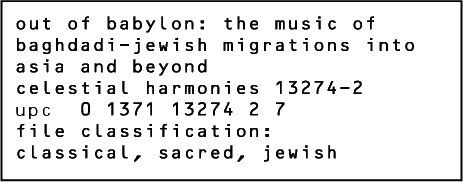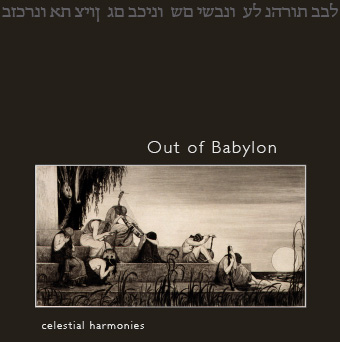 |
|||||||||||||||||||||||||||||||||||||||||||||||||||||||||||||||||||||||||||||||||||||||||||||||||||||||||||||||||||||||||||||||||
 
the projectDas Zweistromland (Aram Beth-Nahrin) zwischen Euphrat und Tigris, Mesopotamien, gilt als die Wiege der abendländischen Kultur; es war die Heimat des Stammvaters und Propheten Abraham. Die legendäre Stadt Babylon war bereits vor 2500 Jahren die erste Diaspora der Juden; das antike Baghdad war auch der Ursprungsort einer bedeutenden jüdischen Zivilisation, die von dort aus die großen Traditionen sowohl der Aschkenasen (Aschkenasim) als auch der Sepharden (Sephardim) maßgeblich beeinflusste. Seit dem späten 18. Jh. hatten sich Händler aus dem wohlhabenden Baghdad in Hafenstädten um den asiatischen Pazifik niedergelassen: Bombay (Mumbai), Kalkutta (Kolkata), Rangun (Yangon), Penang, Singapur, Surabaya, Hongkong und Schanghai, um nur die wichtigsten zu nennen. 1993 entdeckte die australische Musikwissenschaftlerin Margaret Kartomi die Maghain Aboth-Synagoge in Singapur. Die Gemeinde war überwiegend irakischer Herkunft, deren Vorfahren als dem antiken Babylon stammten. Sie folgte den weiteren Spuren über die nächsten 14 Jahre, die dieser Veröffentlichung vorausgingen, wobei sie im Laufe der Zeit auch Rat und Unterstützung von Musikwissenschaftlern aus Deutschland, Israel und Großbritannien erhielt. Überall fand sie, daß die babylonische Lebensweisen ('minagh babli') erstaunlich gut erhalten geblieben waren, was sie anhand der alt-testamentarischen Gesänge dokumentieren wollte. Trotz der großen zeitlichen und räumlichen Entfernungen hatten sich die liturgischen Stile über die Generationen nicht wesentlich verändert. Ein Vergleich mit frühen Aufnahmen von Gesängen babylonischer Herkunft, die im heutigen Israel im frühen 20. Jh. entstanden, zeigte verblüffende Ähnlichkeiten mit der späteren Aufführungspraxis andernorts. Nach dem Ende der Kolonialära, gegen Mitte des 20. Jh., kam es zu einer weiteren Welle von Umsiedlungen und Auswanderungen, sowohl der Juden, die in Baghdad verblieben waren, als auch derjenigen, sie sich schon vorher im asiatischen Raum niedergelassen hatten. Die neuen Ziele waren Israel nach der Staatsgründung, Großbritannien, Kanada, die USA, Australien, und - wenn auch in geringerem Ausmass - Südafrika. Kartomi fand erstaunliche Übereinstimmungen der Gesänge, die sie u.a. in Sydney und Mumbai, Singapur und Hongkong, aufgenommen hatte. Diese CD ist der erste, großangelegte Versuch überhaupt, die geistliche Musiktradition der Juden Baghdads zu dokumentieren und damit für die Nachwelt zu bewahren. Die 42 Tracks geben ausschließlich Gesänge tradionellen und dokumentarischen Charakters wieder. Margaret Kartomi und ihre Kolleginnen Regina Randhofer (Halle), Sarah Manasseh (London) sowie Bronia Kornhauser (Melbourne) haben Jahre ihres Lebens diesem Ziel gewidmet. Historische Aufnahmen aus Israel und Großbritannien wurden ebenfalls zur Vervollständigung des Eindrucks und der Darstellung verwendet, wobei für alle digitalen Überspielungen und Nachbearbeitungen der israelische Tonmeister Gideon Boss verantwortlich zeichnet, dessen Muttersprache hebräisch ist und der mit dem Repertoire von Anbeginn eng vertraut war. Es war auch Gideon Boss, der den Weg zu dem großen deutsch-jüdischen Maler Ephraim Moshe Lilien wies, dessen Illustrationen zum Alten Testament um 1910 größte Bedeutung hatten. Das Motiv auf der Vorderseite des CD-Beihefts ist Liliens Illustration des 137. Psalms, dessen Text das Motto der CD inspirierte: OUT OF BABYLON. Das 64seitige Beiheft mit zahlreichen Abbildungen gibt eine umfassende Einführung in das Wissensgebiet in englisch. In 1993 during a visit to carry out some Southeast Asian music research, Margaret Kartomi stumbled on the Maghain Aboth Synagogue in Singapore. The congregational community she discovered were of Baghdadi descent; their forebears had originated in Babylon, the land of the Tigris and Euphrates rivers and home of the very first Jewish diaspora 2500 years ago. As is well known, the Jewish community of ancient Baghdad went on to found a rich civilisation that would give rise to the great rabbinic academies of learning in the first three centuries CE, and would eventually come to influence the traditions of the Sephardi (literally, ‘Spanish’) and Ashkenazi (east European) Jews. From the late 18th century, Jewish merchants from the rich and
famous city of Baghdad settled in port cities around colonial-British
and colonial-Dutch Asia, such as in Bombay, Calcutta, Rangoon,
Penang, Singapore, Surabaya, Hong Kong and Shanghai, where they
plied their wares or ran their shipping, spice and clothing businesses.
Kartomi visited and studied the music she recorded of some of
these communities; and fellow ethnomusicologist Sara Manasseh
researched the Baghdadi-Jewish music of her hometown, Bombay.
As they found, families such as the Sassoons and the Kadooris
had made significant contributions to life in their local cities,
such as setting up the tramcar system in early 20th century Hong
Kong; but they also lovingly maintained the Baghdadi way of life
(minagh babli, ‘Babylonian custom’) across the generations,
built Baghdadi-style synagogues and practised their music-liturgical
tradition in their numerous synagogue services. To this day the
community claims that they have succeeded in preserving their
ancient tradition, singing many of the same liturgical melodies
as in past generations. Research has shown that some of the songs
sung today resemble those recorded by the musicologist Idelsohn
in the Baghdadi community in Israel early in the 20th century,
although the styles of singing vary according to the background
and experience of each singer. tracklist
|
|||||||||||||||||||||||||||||||||||||||||||||||||||||||||||||||||||||||||||||||||||||||||||||||||||||||||||||||||||||||||||||||||
|
|
|||||||||||||||||||||||||||||||||||||||||||||||||||||||||||||||||||||||||||||||||||||||||||||||||||||||||||||||||||||||||||||||||
 |


